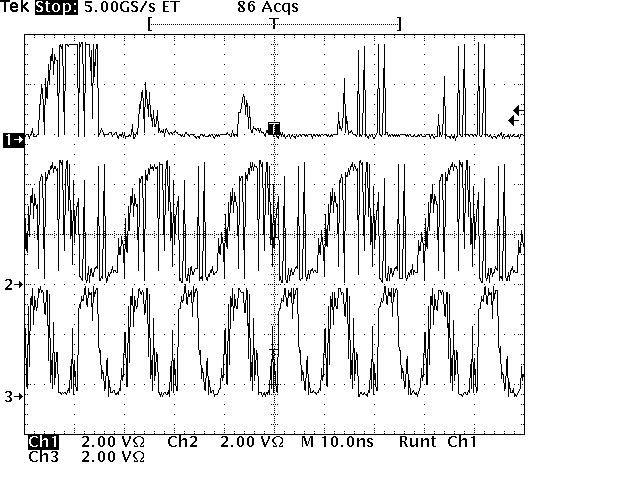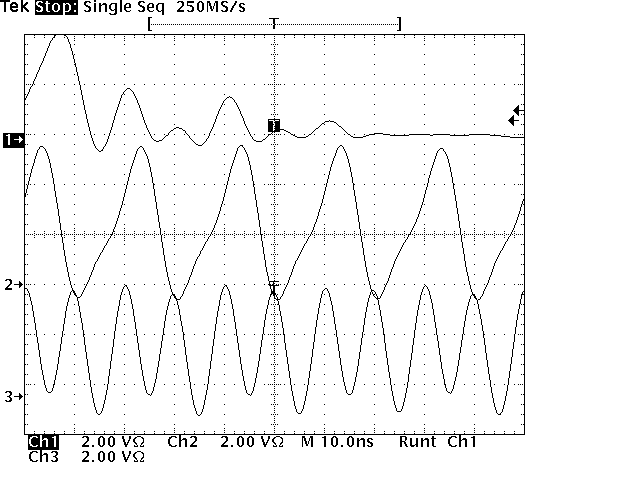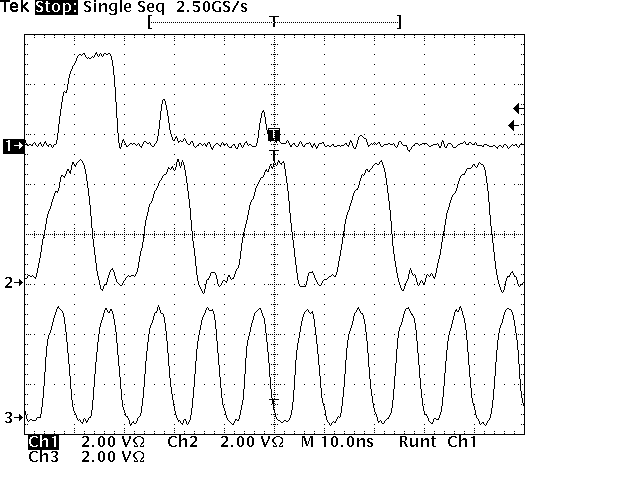
Figure 1. Example of waveforms acquired through equivalent-time sampling. A distorted display with artifacts is evident.
The advent of the digital storage oscilloscopes (DSO) gave users a new way to look at signals. Waveforms of interest could be captured, processed digitally and stored, providing users with the opportunity to analyze the waveform in greater detail.
Yet, the DSO had its shortcomings. It could not sample certain signals accurately, especially at higher bandwidths, because of technological limitations within their signal acquisition systems. As such, the true character and detail of many waveforms was simply under-represented.
To compensate for the DSO's lack of sample rate performance, scope manufacturers developed alternative solutions. Two approaches were equivalent-time sampling and channel interleaving. With equivalent-time sampling, information is acquired, built and displayed over multiple triggered acquisitions of the signal waveform. However, the input signals must be repetitive in order to generate the multiple triggers, and the DSO cannot create a meaningful display from a one-time event. Also, an irregular waveform--one that does not repeat the same waveshape in every cycle--results in a distorted display, showing confusing artifacts. See Figure 1.

An approach known as interleaving improves sample rate performance by drawing on unused channels' digitizing resources. This technique can provide more accurate signal acquisition on one channel, but consumes the DSO's other channels while doing so. When these additional channels are used instead to observe other signals, interleaving is not possible, and sample rate is effectively halved-compromising accurate signal sampling and reconstruction. See Figure 2.

A block diagram of how a conventional DSO utilizes interleaving is shown in Figure 3.

In cases where equivalent-time sampling and interleaving were acceptable approaches to the task at hand, the user had to become knowledgeable in sampling techniques, and master the intricacies of DSO configuration through button pushing, knob turning and adapter connecting. The difficulty of capturing infrequent anomalies in a repetitive signal environment, long a challenge to conventional DSO architecture, was overcome in 1994 when the Tektronix TDS 700A Series was introduced. These scopes added a new technology called InstaVu™ acquisition which substantially improved sampling throughput by reducing dead time between acquisitions. As a result, up to 400,000 waveforms per second can be captured, and through a rasterization process, displayed at a level of detail that reveals aberrations. Scopes with InstaVu acquisition are ideally suited for applications where elusive system problems manifest themselves intermittently.
For users who needed to capture real-world signals in real time, a new signal acquisition approach called Digital Real Time (DRT) sampling was developed. The new DRT technology made capturing rapidly changing signals of short duration in one pass a reality.
Digital real time sampling affords true 4-7 times signal oversampling on all channels simultaneously. Scopes with DRT acquisition systems are ideally suited to applications very fast edge transitions, high bandwidths, or, particularly, one-time momentary events. See Figure 4.
 Figure 4. Three waveforms captured concurrently through DRT acquisition.
Unprecedented signal detail is gained through this technology.
When compared to the same signals captured on a conventional DSO
as shown in Figure 1, the difference is readily apparent.
Figure 4. Three waveforms captured concurrently through DRT acquisition.
Unprecedented signal detail is gained through this technology.
When compared to the same signals captured on a conventional DSO
as shown in Figure 1, the difference is readily apparent.DRT acquisition provides several important and key advantages over conventional approaches:
The Tektronix development team leveraged core skills in several areas as they began developing this unique DRT system. Extensive experience in high-speed ASIC, analog circuits and sampling system design was applied to the DRT system's core functionality. See Figure 5. Finally, circuit integration skills were applied to implement the DRT system in a minimal chip set. Combined, these factors make DRT a scalable CMOS technology that can be quickly adapted to a variety of physical packages.

Digital storage oscilloscopes employing DRT acquisition technology address customer needs across four dimensions:
The Tektronix DRT signal acquisition system is the only approach available that addresses the dimensions of performance, price, package, and power at the same time. The company's portfolio of products supports user needs in diverse and unique applications where accurate signal measurement is important. See Table 1.
+-------------+--------+---------+---------+-------------------+
| Instrument | # of | Band- | Sample | Applications |
| Series | Models | width | Rate | |
+-------------+--------+---------+---------+-------------------+
|TDS 600B | 4 | 1 GHz | 5 GS/s | Advanced Design |
| | | | | and Research |
+-------------+--------+---------+---------+-------------------+
|TDS 300 | 3 | 400 MHz | 2 GS/s | Basic Design |
+-------------+--------+---------+---------+-------------------+
|THS 700 | 2 | 100 MHz |500 MS/s | Field Service, |
| | | | | Maintenance |
+-------------+--------+---------+---------+-------------------+
|TVS 600 | 4 | 1 GHz | 5 GS/s | Manufacturing Test|
| | | | | and Research |
+-------------+--------+---------+---------+-------------------+
|TLS 216 | 1 | 500 MHz | 2 GS/s | Advanced Design |
| | | | | and Research |
+-------------+--------+---------+---------+-------------------+
Table 1. A full complement of Tektronix products employing DRT
signal acquisition technology supports diverse and unique user
applications.
For semiconductor and systems-level designers in virtually all disciplines, high clock and bit rates are now the norm. Signal rise/fall times, jitter, wander and transmission line effects can have a severe impact on system timing and performance. In laser and high-energy physics research, the content of short-duration, fast-rise and high-frequency signal bursts must be captured and characterized on many channels simultaneously. Given this, DSOs that employ DRT are key to gaining highly accurate timing and amplitude resolution at bandwidths from 500 MHz to 1 GHz. This performance is delivered by the TDS 600B Series DSOs and the TLS216 Logic Scope.
Today's general-purpose user needs a fast and affordable DSO in order to contend with the increasing signal speeds found in diverse product types. Field service and maintenance personnel need scopes that can readily identify power spikes and fast intermittent events. Additionally, they need a scope with the right form-factor that will work effectively under less than ideal environment conditions. The scalability of DRT puts highly-accurate, multi-channel waveform acquisition at bandwidths up to 200 MHz in the low-cost benchtop TDS 300 Series, and in the affordable, light-weight and battery operated THS 700 Series scopes. These products are ideally suited for on-location troubleshooting and fault-isolation in computer systems, automotive electronics, telecommunications equipment and avionics systems.
In manufacturing test and research environments, flexible and scalable instrumentation adaptable to rapidly changing products and projects is a must. TVS 600 universal wavefrom analyzers which are VXI implementations that use DRT technology, provide for small, modular instrument configurations that offer unmatched channel density, a minimal footprint and computer control.
Digital real time acquisition from Tektronix is a proven technology that delivers unprecedented levels of performance. DRT provides the most faithful signal acquisition available in a DSO, and allows the full bandwidth of the scope to be realized on all channels simultaneously. Tektronix DRT architecture is easily scaled and repackaged, allowing rapid response to market needs. Digital real time acquisition is the best solution in applications where single-shot acquisition of rare and transient events is crucial.
Tektronix, TriStar DSP and InstaVu acquisition are registered trademarks of Tektronix, Inc. All other trade names referenced are the service marks, trademarks, or registered trademarks of their respective companies.